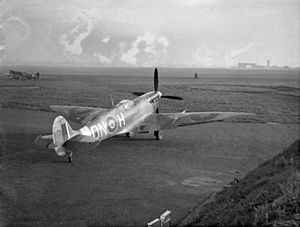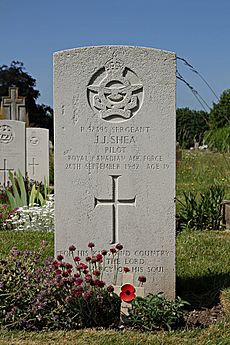No. 124 Squadron RAF facts for kids
Quick facts for kids No. 124 (Baroda) Squadron RAF |
|
|---|---|
| Active | 1 March 1918 – 17 August 1918 10 May 1941 – 1 April 1946 |
| Country | |
| Branch | |
| Nickname(s) | Baroda |
| Motto(s) | "Danger is our opportunity" |
| Insignia | |
| Squadron Badge heraldry | A mongoose passant. The mongoose is an inhabitant of India and is known for its speed and ferocity in killing its enemies. |
| Squadron Codes | PK (Apr 1939 – Sep 1939) ON (May 1941 – Sep 1946) |
No. 124 (Baroda) Squadron RAF was a special unit of the Royal Air Force. It was first created during World War I as a light bomber squadron. Later, it was formed again during World War II to fly fighter planes.
Contents
History of No. 124 Squadron
Early Days in World War I
No. 124 Squadron started on 1 February 1918. It was part of the Royal Flying Corps, which later became the Royal Air Force. The squadron was based at Old Sarum Airfield. It then moved to RAF Fowlmere. The squadron was only used for training pilots. It was officially closed down on 17 August 1918.
World War II Missions

Before World War II began, from April to September 1939, 124 Squadron was given a special code. However, the squadron was not actually set up at that time.
The squadron finally started again on 10 May 1941. It became a fighter unit. They flew Spitfire Mk I planes. Their first job was to defend Scapa Flow from enemy attacks. This started on 29 June. In October 1941, they switched to flying Spitfire Mk IIBs.
The squadron then moved to RAF Biggin Hill. Here, they used Spitfire Mk V planes. They took part in missions against German ships during the "Channel Dash". In April 1942, they received new planes. These were high-altitude Spitfire Mk VI aircraft. They took these planes to RAF Drem for a month in December.
In January 1943, they returned from Scotland. They joined up with the "Special Spitfire Flight" from RAF Northolt. Then they moved to RAF Manston. In early 1945, the squadron was stopping German spy planes. These planes flew very high, up to 50,000 feet! The squadron used Spitfire Mk VIIs for this. These planes had special cockpits that were pressurised, like in modern airplanes.

In February 1945, the squadron started using Spitfire Mk IX.HF(e) planes. Their main job was to attack mobile launch sites for V2 rockets. These rockets were being launched by Germany. The launch sites were mostly hidden in woodlands near The Hague in the Netherlands.
On 10 February, the unit moved to RAF Coltishall in Norfolk. This base was closer to their targets, about 120 miles away. The V2 rockets were developed by Wernher von Braun. The first V2 rockets hit London in September 1944. 124 Squadron was one of six Spitfire squadrons. Their mission was to try and destroy these mobile launch sites. These missions were called "ramrods" by the RAF. A ramrod was a daylight bombing mission against a specific target.
The attacks were done in two ways:
- Full Bomb Load: On some days, the squadron got permission to use airfields in Belgium. Each plane would drop a 1000 lb bomb load. This included a 500 lb bomb under the plane and two 250 lb bombs under the wings. After the attack, they would fly to a friendly airfield. They would refuel there before flying back to Coltishall. Sometimes, they would refuel and get more bombs. This allowed them to attack more V2 sites on their way back to base.
- Lighter Bomb Load: On other days, they could not use the forward airfields. So, the planes carried a 500 lb bomb. They also carried an extra fuel tank. This tank was needed for the longer flight. They would drop the extra tank when they got close to the Dutch coast. Then they would switch to their main fuel tank.
Before each mission, there were early morning flights. These flights took photos or checked the weather. This helped them find the latest V2 launcher positions. It also checked for good visibility and cloud cover. After a briefing, the Squadron Leader would find the target area. He would then lead all twelve planes in the attack.
124 Squadron's dive-bombing attacks usually started at 11,000 feet. They would dive steeply at a 60-degree angle. They aimed to release their bombs at 4,000 feet. During the dive, each pilot tried to spot the rocket launcher among the trees. Pulling out of the dive at 350 mph caused strong G forces. These forces could make pilots temporarily black out. To help with this, pilots would set their planes to pull up automatically. This would happen if they relaxed their grip on the controls. The main danger on these missions was not enemy fighters. It was heavy anti-aircraft fire, especially along the coast.
Besides "ramrods," the squadron also flew "interdiction" missions. These were low-level attacks. They were often flown when the clouds were too low for dive-bombing V2 sites. Their goal was to find and bomb railways and other targets. This would stop the enemy from moving rocket supplies. Interdiction missions were flown from Coltishall. They used four planes at a time. Each plane carried a 500 lb bomb and extra fuel tanks. For these missions, the bombs had an 11-second delay. This gave the last plane time to clear the area before the bombs exploded.
The squadron also escorted bombers during daylight raids on Germany.
On 7 April, the squadron moved to RAF Hawkinge. Their last mission was on 25 April. This was after the Allies freed the Netherlands. On 27 April, the squadron moved to RAF Hutton Cranswick for training.
On 24 August 1945, 124 Squadron moved to RAF Molesworth. Here, they began to train on the Gloster Meteor. This was the RAF's first jet fighter plane. In October, the unit moved to RAF Bentwaters. In February 1946, they went to RAF Fairwood Common. The squadron was officially closed down at RAF Bentwaters on 1 April 1946. It then became No. 56 Squadron RAF.
Aircraft Used by No. 124 Squadron
| From | To | Aircraft | Squadron code |
|---|---|---|---|
| Feb 1918 | Aug 1918 | Airco DH.9 (proposed) | |
| Feb 1918 | Aug 1918 | miscellaneous training aircraft | |
| Apr 1939 | Sep 1939 | Squadron not stood up | PK |
| May 1941 | Oct 1941 | Supermarine Spitfire Mk.I | ON |
| Oct 1941 | Nov 1941 | Supermarine Spitfire Mk.IIB | ON |
| Nov 1941 | Jul 1942 | Supermarine Spitfire Mk.V | ON |
| Jul 1942 | Feb 1943 | Supermarine Spitfire Mk.VI | ON |
| Mar 1943 | Feb 1945 | Supermarine Spitfire Mk.VII | ON |
| Feb 1945 | Jul 1945 | Supermarine Spitfire Mk IX.HF(e) | ON |
| Jul 1945 | Oct 1945 | Converting to Meteor at No. 1335 CU | |
| Oct 1945 | Apr 1946 | Gloster Meteor F.3 | ON |

